Newsletter 48
26/09/11
Rhino War
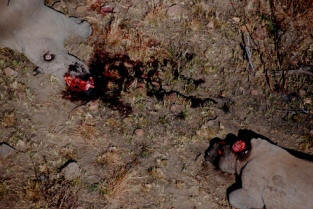
Rhino's killed by poachers
Rhino poaching statistic in SA for last few
years:
2007: 13
2008: 83
2009: 122
2010: 333
2011: 287 (till 8th September)
Despite extensive television coverage and print
media, the rhino poaching syndicates continue to deplete South Africa's
rhino populations.
Rhino breeders have appealed to the Government to
allow them to trade the rhino horn, just like a farmer trades the
wool from his sheep.
All of this has fallen on deaf ears and the
Government, in my opinion, has shown little or no leadership in this
war against the rhino syndicates.
There is strong evidence that poorly paid
officials in the Provincial Departments are colluding with the
syndicates and permits are being issued and a "blind eye" turned when
necessary.
I have personally written to the President and
the Minister of Wildlife and Tourism, but the bureaucratic replies, I've
received, are totally inadequate.
I may just point out to the President that the
rhino is an extremely valuable asset to South Africa in terms of a
job creator.
The white rhino especially, is the second biggest
land mammal in South Africa. It has dinosaur like features and many
photographers rate it as one of their favorite animals to
photograph.
Two people who are at the front line of the rhino
war, are helicopter pilot John Bassi and veterinarian Dr. Charlotte
Moueix.
This is their story:
Most of the time it’s a privilege
flying free every day with open space and wildlife abounding, lately
however it sickens me.
I climbed to 1,500 feet above
ground to benefit from the amazing tail wind bringing me Northwards from
the central Free State where the clouds were darkening. Another cold
front was sweeping through the interior of South Africa, leaving a trail
of ice and snow in its wake, a major inconvenience since I was relying
on working in rough country and we needed good visibility. The following
morning I painfully finished a preflight, hardly able to move my arms
and head due to the five layers of clothing that were cocooning me. It
was only 8:30 am but the freezing wind was already restlessly brushing
and plucking at the tall golden grass all around the helicopter. I gazed
with apprehension towards the seemingly endless jumbled mass of
mountains in every direction. My stomach tightened with nervous
butterflies as I imagined how it would soon feel to be hammered by the
turbulence in the deep valleys where I would be spending the next 14
days. At least the visibility was amazing, all the dirt and muck in the
atmosphere had been blown away, replacing the gray smudge with crystal
clear blue sky. The sun was feeble; the weather-man had said it would be
a maximum of +6c, without the wind chill. The helicopters blades were
blanketed in a fluffy white frost, an occurrence delaying our take off
each day until 9 am, when the ice would finally succumb to the suns
attempt at warmth and drip away.
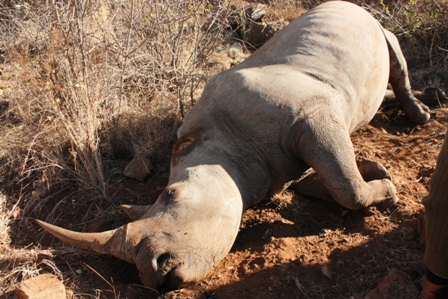
A large rhino horn can fetch R1 million on the black market
My task was to provide air support
to the counter poaching teams or CPU’s, patrolling the entire game
reserve in a methodical and on going basis. Each day we would cover
around 20 000 hectares, needing to be airborne from the HQ as soon as
there was good light, then fly out to a different quadrant where we
would remain aloft for most of the day, refueling from drums every 3
hours. Our goal was to account for each and every rhino, searching every
gulley and hill while praying we would not come across new carcasses,
wishing that we would be blessed with the luck to discover poachers and
get our revenge. For this operation, the perfectly clean, clear light
would be a huge bonus; the bitterly cold air would be all I could ask
for to improve the helicopters performance, although the relentless wind
was a problem. Blowing at 8 meters per second from the south with
stronger gusts, combined with the rotary turbulence that was lurking
behind the hills, the wind presented some danger. I examined the
contours of the topographic map for the day’s section, relieved to
discover that most of the high terrain and valleys ran in an east/west
orientation. This would be my preferred direction of transects during
our sorties. The prevailing wind was southerly which meant that I would
mostly have the option of benefiting from up-draughts on the ridges,
also a cross wind was safer to work with than a tail wind.
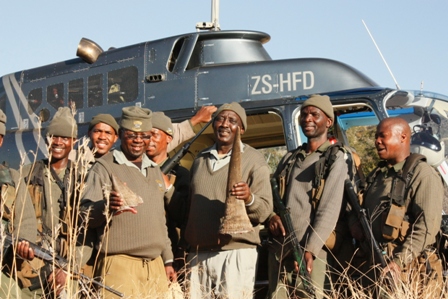
Anti poaching crews with confiscated rhino horn
Armed with 7.62mm FN Browning’s,
clad in military style webbing and camouflage, the scary looking
anti-poaching team arrived, fully kitted for their deployment to a
remote mountaintop. They would be spending the next few days out on
patrol, relieving another “stick” that would be walking out to a remote
pick up point, awaiting my arrival. The tired guys, lead by Seymor were
still perched snugly between bushes on the top of a strategically
positioned hill, an observation post, concealed so as to not compromise
themselves as they watched the world below. Discipline and trust is a
prerequisite when combining helicopters with eager men, armed with
semi-automatic assault rifles, low flying and confined landings. Due to
the necessity of having unobstructed visibility, rapid de-bussing, the
possibility of opening fire onto armed poachers and the safety aspect of
keeping loaded weapons pointing outside the aircraft, we would always
fly, doors off. The biting cold wind was almost unbearable while flying
for a few hours at a time with no break, imposing the added danger of
losing articles of extra clothing in the form of gloves, scarves or
balaclavas. Items that could easily fly through the tail rotor if blown
out of the cabin by an unexpected gust, hit the tail rotor and certainly
bring us all to a spinning end.
After double-checking my
passenger’s security, I maneuvered myself into my seat for the start up.
Although simple enough, lighting the turbine takes huge electrical power
and is a procedure that I perform with apprehension in sub zero
temperatures. Using a 24volt booster pack as security reduces the risk
of a hot start that could result from the power loss in the main
battery, from a freezing night. We lifted off from the helipad into the
fresh breeze that plucked the fully fuelled aircraft skyward with almost
800 feet per minute indicated on the vertical speed indicator, but the
chill made us all gasp with fright. Our eyes were watering and we
attempted to huddle ourselves out of the airflow, setting course for the
20minute ferry to the remote wilderness area. The morning sun unable to
reach any of the valleys, left them cast in deep shadows and frosted in
white, in contrast the warming slopes of the hills provided comfort to
herds of game. A false cense of peace prevailed as we floated over zebra
and wildebeest that reluctantly trotted away from our brief imposition,
the tail wind catapulted us forward, detached from reality, our shadow
grew and shrunk over the undulating terrain.
On reaching the starting point of
our first session, I descended into a wide, open valley, blackened with
ash from a recent fire, the low rays from the morning sun accentuating
the new flush of green shoots of grass, a real delicacy for rhino. The
helicopter crabbed its way along, 150 feet above the ground, attempting
to hold a straight track up and down the mountains, deviating only to
glance a peek into shadowed ravines and onto hidden knolls. With our
combined eyes peeled in search of rhino, we continued, back and forth
along 400 meter wide transects, averaging 60 knots groundspeed, slowing
and descending to identify, photograph, sex and age each individual that
we came across. Approaching another gradually sloping mountainside that
we would need to climb over, I lowered the helicopters nose to
accelerate, simultaneously pulling in some power, banking slightly to
benefit from any up-draughts. Suddenly the all too familiar rotting
stench of death filled the air, banking into the wind we followed the
smell like a foxhound, then, next to a line of trees below lay the
rotting carcass of another rhino. The drill had become routine, with 692
dead rhino in South Africa over the last 29 months, but the sadness
never goes away. Icicled, climbing to 1000 feet in order to make line of
sight radio contact with a ground team, the silence inside the cabin
matching the glum expressions on everyone’s faces, I called in the
closest game scouts. I selected a safe landing site near a deep donga
surrounded by large trees and turned onto a short final approach aiming
for a small, dust free flat opening just large enough for the
helicopter, 100 meters from the dead rhino. This would be my LZ for the
next few landings and I made sure that I had all my markers perfectly
memorized, such as a small dry stump a foot in front of the right skid,
such things ensure that every landing is made in precisely the same
place, avoiding a blade strike. It is during times like this that I
appreciate the benefits of working with a trained crew, there is no way
that its practical to go through the delays of closing throttle,
applying frictions, untangling oneself to help everyone out, fastening
their safety harnesses, headsets etc. before reversing the entire
procedure. The CPU’s departed from the aircraft giving me the thumbs up,
signifying that all was secure, with peace of mind I lifted the
collective and climbed away vertically to minimize dust, setting course
for the forensics team and all their gruesome equipment. The area around
the carcass would be searched for clues; police forensics conducted an
autopsy and recovered the bullets and any other evidence and another
rhino got scratched off the list. During my approach for landing not too
close to the carcass for fear of blowing away evidence, a brown hyena
loped off, guiltily looking back over his shoulder, while a group of
pied crows scattered away between the trees. The young bull lay twisted
with his head facing down hill, the top of his face chopped away with an
axe. The trackers located blood a few hundred meters away, east along a
well-used game trail coming down the hillside. Later with the aid of a
metal detector, two mushroom-shaped military .303 bullet heads were
found. One, from a hurried shot that wounded the animal in the lower
back the other, a round that penetrated the rhino’s lungs, allowing him
enough strength to run down the hill before collapsing in a frothy pool
of blood.
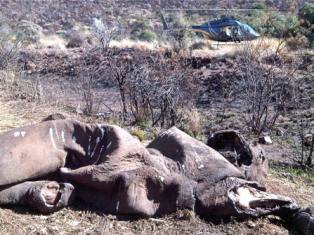
We arrived too late to catch the poachers
Our butcher’s work done, we
returned to the helicopter to swap over the CPU teams and continue our
patrol, lifting off with the detached feeling that comes with flight,
leaving the putrid remains for the scavengers. Picking up our last
transect, we continued our search, each of us absorbed in our own
thoughts of anger and defeat, willing a poacher to show his face for
just a second. The shadows grew longer as the late afternoon came upon
us, visibility rapidly deteriorated from 4pm and we had all become
frozen to the bone, and so, calling it a day we turned for home. At the
helipad we were welcomed by the news that a long horned rhino cow had
been seen by tourists, badly wounded, limping with a calf trotting
ahead. It was too dark to fly and still had to clean and inspect the
aircraft, re fuel and tidy up, organize the following days fuel drop,
flying crew and download the days data, leaving barely enough time to
cook, shower and sleep.
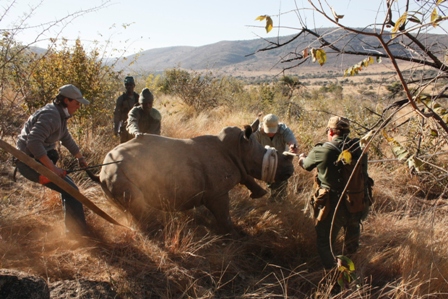
Capturing rhino to remove the horn
All too soon the alarm clock went
off, leaving me startled in the semi darkness with a mind full of
thoughts of wind, mountains, dead rhinos and memories of how cold I
would soon be. By 9am we were back in the morning sky, cruising along,
resuming our mission in the North Eastern corner, searching desperately
for long horn, to no avail, then southwards into an area that has been
particularly hard hit by poachers over the last 18 months. We all felt
stupidly relieved to be making such a presence with the helicopter,
thinking that this would act as some kind of temporary deterrent to the
savages. We had just settled into our routine of searching when one of
the beige colored land cruisers operated by field rangers appeared,
hurtling towards us followed by a plume of brown dust, the driver
frantically waving to get our attention. I selected his frequency on the
HF radio and deciphered from his high pitched, excited voice that
trackers had found new holes cut in the electric boundary fence and that
poachers were in the park. Receiving the description of the scene, I set
the needles to maximum power and we accelerated towards the trackers
location, unsure of what to expect, but filled with anticipation. New
information that we received en-route was conflicting, however we had
the name of a valley where we were needed, fast, and we had high
expectations of action. Arriving overhead the scout who was waiting at
the place where the fence was cut, he pointed in the general direction
that we should head. We would need to pass over a small ridgeline, turn
left around the foot of a mountain and enter the valley at high speed,
low level, maintaining an element of surprise. We still did not have
radio contact with the trackers but felt sure that the moment we arrived
on the scene we would manage to communicate, hoping that the unexpected
arrival of a helicopter would panic the poachers, forcing them to hide.
This would give the trackers an advantage to run on the spoor and
together we could get lucky and ambush the poachers, who would not stand
a chance with our combined firepower.
Our nerves were coiled like cobras
ready to strike as we rounded the entrance to the valley at 160
kilometers per hour, climbing to 500 feet and calling on the radio,
ready to offer instant support to the men on the ground. None of us were
ready for the anticlimax and shock that lay before us. The two white
rhino lay a few meters from each other, their crimson red blood spilled
in pools onto the earth, scarlet gaping wounds glared mockingly up at us
from their uniform gray bodies where their horns should have been. The
two adult rhino lay facing each other, lifeless, but so freshly killed
that they were not even cold. The poachers were long gone, leaving
behind two more of Gods beautiful creatures, slaughtered for human
greed. Both had been killed instantly by high powered rifles fired from
only 20 meters away as both rhino lay sleeping. The adult cow was
pregnant with a six-month fetus. Two days later we were back in the same
area responding to another report of holes cut through the fence, then
during our search we found a motionless, forlorn looking rhino calf,
alone and sad, a few hundred meters from the two carcasses. We descended
to look closer, realizing that we had discovered a 15month old orphaned
youngster; her mother lay rotting nearby.
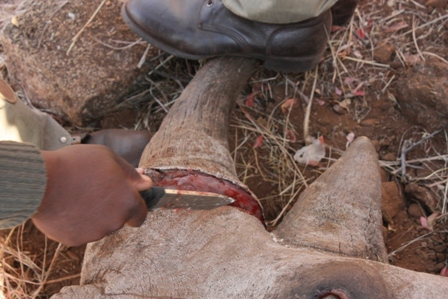
Removing the horn before the poachers can get to it
What, you may well ask is being
done by the “authorities” to try and stop this destruction? Nothing.
This question takes me back twelve years to a charter flight I once did,
transporting a VIP pseudo conservation politician to address the Game
Rangers Association of Africa. This annual meeting is a forum of
representatives from all over Africa, from all the major conservation
organizations. Standing at the podium presenting the opening address to
the delegates, this man screwed his face up into a tight frown. He shook
his head in disapproval and slowly spat out the words, “What I see here
before me, disgusts me, an elitist minority organization. There will be
no money to protect your rhino. For the next 30 years the only money
that will be spent will be for the community, so, if you want to protect
your rhino, you will need to find your own money." This remark I have
since discovered was an understatement! This is the bottom line, the
reason we are losing the war against poaching. There is NO funding what
so ever from the state to fight the fight. The only support to the few
determined individuals who actually manage to do something positive,
comes from public donations and handouts.
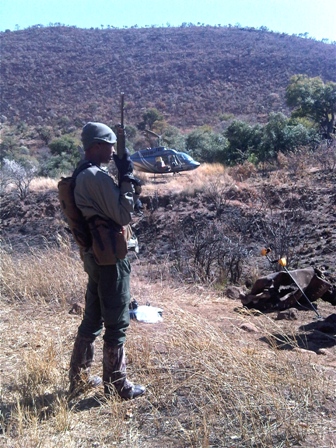
The helicopter is a vital tool in combating poaching in rugged terrain
We had been working eight days and
were back in the central section of the reserve for a couple of hours
one morning, we had settled back into flying transects, having guided
the field rangers onto the carcass of the long horned cow. Her calf no
where to be seen, long horn had managed to move 2 kilometers from her
last known position, she had laid down inside a bushy thicket and given
in to her wounds. Tired and hungry I turned the helicopter and
approached the fuel drop off point where I knew we had very needed
toasted cheese and tomato sandwiches with hot, sweet, milky coffee
awaiting us. Instead, confusion reigned on the ground when I landed,
there were broken urgent messages from the observation post on the
western border. They had three, armed poachers visual, walking in broad
daylight a kilometer inside the reserve, hugging a river line at the
foot of a hill and moving into a thicket of Tambotie trees.Seymore
shouted excitedly over the radio," Wearing a white T-shirt and denims,
one carrying a red bag, two weapons, another in a brown shirt and khaki
longs, 300 meters from the OP and moving west”. In a mad rush we pumped
another two hours worth of fuel into the helicopter, grabbed air to
ground radios, three 20 round magazines of ammunition and with three
armed scouts ready, headed back skyward. With adrenalin filled veins,
complete focus, nerves on high alert and this time, utter determination
to kill, we flew as fast as the helicopter would allow. Planning the
route carefully, staying low and using the valleys to shield the
slapping of our advancing rotor blades, we headed towards the unknown.
Ground troops mobilized from two directions to assist in a sweep of the
river line from east and west, simultaneously as we crept low level all
along the river, firing shots at will into thick clusters of bushes,
nothing moved. Four tense hours we spent, searched every nook and cranny
shooting into every possible hiding place, the scouts on the ground
moving in an extended line behind a tracker, spoor from three poachers
split into three directions. Even with the combined operations of SAPS
dogs, the flying squad, a police helicopter with infrared vision
capability, eight ground scouts, trackers, the men on the OP and our
selves, somehow the poachers escaped. We were all very despondent.
We continued flying every day,
finding 13 dead rhino in as many days, we also successfully captured the
first little orphan. Two days later we discovered another little girl,
standing next to her bloated dead mother, her huge worthless horns still
intact because she managed to escape, as long horn did, only to die
later from her bullet wounds. We all thought we had done such a good
thing capturing the two young rhino, placing them together and offering
them protection from the ever-prowling lions, sadly neither of them
could adapt to captivity. Arriving at the pens early on the second
morning with fresh bales of fodder laced with sweet molasses, we were
greeted by the motionless body of the youngest calf. Everyone available
went searching for long horn’s 15 month old bull calf, hoping to capture
him before the lions did, but we never found him. The days blended into
nights in a hazy and surreal manner with blurred and mixed up memories
of death, exhaustion and defeat.
If you wish to help fight this war
please contact me or look at
www.stoprhinopoaching.com
John Bassi
CEO, Chief Pilot
Bassair Aviation
Cell: +27 82 892 9444